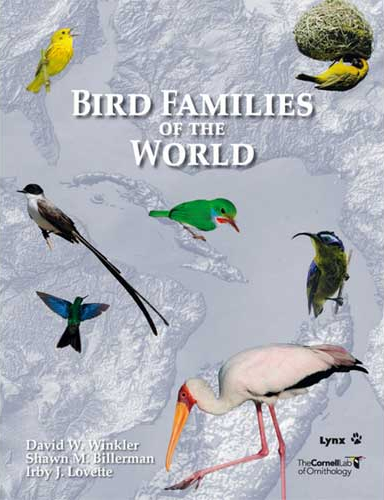Bird Families of the World
14 April 2016 · Leo Stegeman · 4909 × bekeken

David W Winkler, Shawn M Billerman & Irby J Lovette 2016. Lynx, Barcelona & Cornell Lab of Ornithology, Ithaca. 600 pp. Hardcover. Prijs: € 87,00.
After the famous Handbook of the Birds of the World (HBW)-series ended, Lynx produced ‘The Checklist of the Birds of the World' (Volume I) and now there’s another tome from Barcelona, ‘Bird families of the World’.
This is more-or-less a new ‘episode’ in the well-known series of Lynx, with the familiar lay-out, although this time it’s a collaboration with The Cornell lab of Ornithology; and all three authors are actually from Cornell.
The thirst thing that many birdwatchers, including myself, may ask themselves is: “Why this book?”. After HBW, the Checklist of the birds of the World en HBW-Alive, what is the reason for producing yet another handbook, but now dedicated to bird-families? Well, I think there is no good reason! But, on the other hand, one doesn’ t need a good reason to produce such a high standard handbook! Because, as you may have expected, this publication is of outstanding quality. And fortunately the price is about half of each of the HBW-volumes.
All 243 bird families are represented by a map of the world distribution of the family, and accounts of the description, habitat, food, breeding, conservation and relationships of the family. There are paintings of a bird of every genus within the family, and some photographs.
The photographs are of the usual very high standard, although a few have been published before. The number of photographs seems to be spread very unevenly over the bird-families; the monotypic Pandionidae (the Osprey(s) gets two pictures, but the large familie of Hawks and their allies (Accipitridae) - with 248 species - is represented by just three! And the family of Hummingbirds (Trochilidae), 363 species, only has three photographs as well!
The maps and texts are very accurate. I found just one omission; in the distribution-map of the Sandgrouse (Pterocidae), Madagascar is not included, while next to the map a photograph is shown of Madagascar Sandgrouse.
The introduction is a very interesting read; with a comparison of the number of endemic bird-families per biogeographic region, for example. And the introductory chapter about avian systematics - although a tough subject - is explained very understandably. The taxonomy used in the book follows the ‘Illustrated Checklist of the Birds of the World’ (of which only the first volume, with non-passerines has been published at the moment). At species-level, the taxonomy used in the Illustrated Checklist caused much discussion (see this review²). However, at the family-level this book will probably prove to be less controversial. This because the classification of the families presented is widely accepted.
The book is updated up until 2015. For example, one can even find the most recent placement of the Rufous-throated White-Eye Madanga ruficollis within the Pipits and Wagtails (Motacillidae). Even three ‘new’ families are presented; the Chaetopidae (South-African Rock-jumpers), the Hylocitreidae (monotypic, with the Olive-flanked Whistler from Sulawesi) and the Modulatricidae (with some not well-known African songbirds, the Spot-throat and allies). These families are in fact not new, but have now been formally published for the first time.
Personally, I find the parts where the relationships of each family are being explained, the most interesting ones. Although nothing new is presented here, one will always be surprised by some relationships. For instance I was surprised to read that Larks (Alaudida) are seemingly most closely related to Bearded Reedlings (Panuridae)! Or what about Long-tailed Tits (Aegithulidae) apparently being more related to the Leaf Warblers (Phylloscopidae) than to other Tits (Paridae)? Surprisingly, the Falcons (including Caracaras; Falconidae) are closer to Parrots, Owl, Cuckoos and Turacos than to the other raptors. And who would have guessed that the Tropicbirds (Phaethontidae) are the closest relatives of Sunbittern and Kagu (Eurypygiformes), and that Grebes (Podicipedidae) have a sister relationship with Flamingoes (Phoenicopteridae)? Maybe even more surprising is the fact that there is evidence which suggests that Skuas (Stercorariidae) are a sister group to the Auks (Alcidae), rather than to Gulls (Laridae).
These examples make it clear that there is still much to be resolved in relationships of birds. Interesting stuff!
The authors call the book an exploration of the spectacular avian diversity. For me the book is indeed a fitting tribute to the incredible variety of birds.
Leo Stegeman

